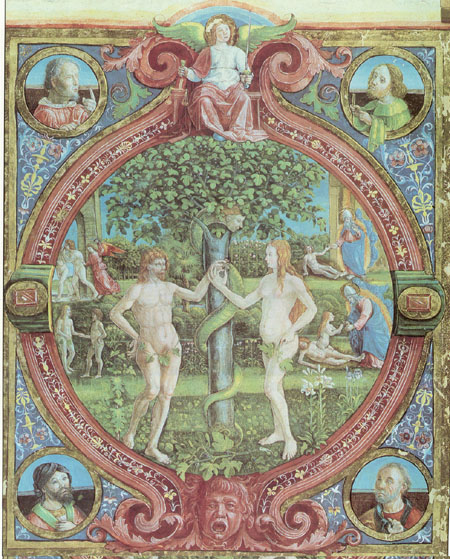|
Delahoyde & Hughes
Orpheus
EDEN
|
 |
The story of the Fall has been so central to the development of Western
culture that Adam, Eve, the garden, the serpent, and the forbidden fruit
have come to function as a constellation of archetypes, and these
components are recognizable symbols even individually. When reading the
first chapters of Genesis, note the differences between the text itself
and what centuries of interpretation and popular culture have distorted
it into. For example:
Visual depictions from artwork to cartoons have affected how we imagine
the story. But below are examples showing an interpretive feature of the
story from the medieval period that manifested itself in a peculiar way.
|
Medieval art such as this Franco-Flemish piece can depict several scenes separated in time all within one frame. This one can be read from left to right, like a comic strip without frame divisions, with moments from the story in Genesis 2 and 3. Perhaps most unexpected for us is the depiction of the serpent. Whom does it resemble and what are the interpretive implications of this? God's halo is represented as two-dimensional here, but this is actually more sensible than those neon rings one sees suspended above the heads of holy persons. The halo is a sort of aura, so it should be emanating, not depicted as a levitating crown.
|
 [From Les Très Riches Heures du Duc de Berry, 1411-1416.] |
The circle is an important, basic, mythological image, as Jung knew. Mandalas, rings, journeys, dances -- whatever the circle, it is expressive of eternity and also of wholeness and completeness. The perfection of Eden is contained herein, and the first couple's exit outside the circle, to the right, may be the beginning of an heroic adventure for humanity, but it's also a grim expulsion from the safety of the happy enclosure.

[A Miniature from Florence.] |
Here again, a peculiar-looking serpent. Why? What else do you see depicted? Why does the artist foreground this frozen moment at the tree? How does the placement of the figures make several interpretive points? What is happening at the very center of the image and what does it mean? |